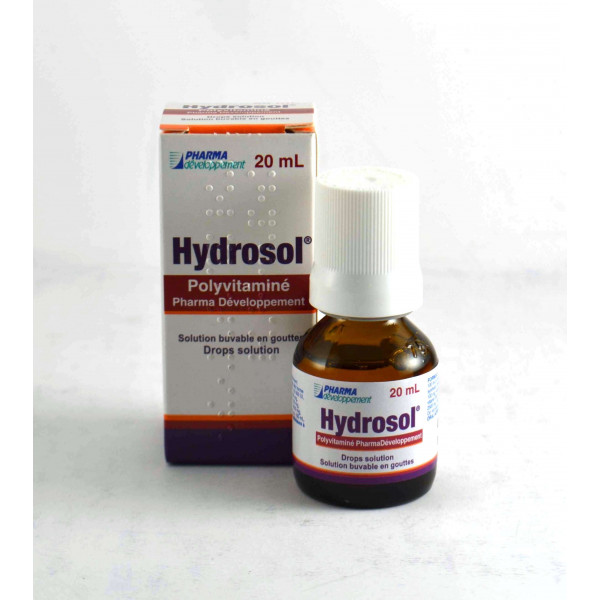1. NAME OF DRUG HYDROSOL POLYVITAMIN PHARMADEVELOPMENT, drinkable solution in drops. 2. QUALITATIVE AND QUANTITATIVE COMPOSITION Synthetic vitamin A (concentrate) oily form*: 250,000 UI Ergocalciferol (vitamin D2): 50,000 UI α Tocopherol (acetate) (vitamin E): 100 mg Thiamine (hydrochloride) (vitamin B1): 100 mg Pyridoxine (hydrochloride) (vitamin B6): 100 mg Riboflavin (sodium phosphate) (vitamin B2): 75 mg Nicotinamide (vitamin PP): 500 mg Ascorbic acid (vitamin C): 2500 mg Dexpanthenol (vitamin B5): 200 mg Per 100ml of drinkable solution. * In the form of vitamin A palmitate stabilised with butylhydroxyanisole (9 mg/1 g) and butylhydroxytoluene (9 mg/1g). 15 drops (0.6ml) = 1500 UI of vitamin A and 300 UI of vitamin D. 20 drops (0.8 ml) = 2000 UI of vitamin A and 400 UI of vitamin D. 25 drops (1 ml) = 2500 UI of vitamin A and 500 UI of vitamin D. To see a complete list of dilutants, see section 6.1. 3. PHARMACEUTICAL FORM: Drinkable solution in drops. 4. CLINICAL DATA 4.1. Therapeutic Indications Prevention or correction of disorders related to a deficient or unbalanced diet. 4.2. Dosage and how to use Orally. The drops can be diluted in water, milk or fruit juice; making sure all liquid is absorbed. Adults & Adolescents: 25 drops per day. Children 4-12years old: 20 drops per day. Children 1-3 years old: 15 drops per day. This is not suitable for children under 1 year. 4.3. Contraindications: This drug is not recommended in the following cases: - Hypersensitivity to one of its components in particular paraben. - Difficulty in absorption of lipids. - Chronic malabsorption. - Therapeutic treatment interfering with vitamin A absorption. - Hypercalcemia, hypercalciuria, calcium lithiase. - In association with levodopa (see section 4.5). 4.4. Special warnings and side effects · To avoid an overdose, take into account the total doses of vitamin A and vitamin D if several therapies containing these vitamins are combined. · In case of calcium intake, a regular check of the calciuria is essential. 4.5. Interactions with other drugs Inadvisable combinations (Related to the pyridoxine content) + Levodopa Inhibition of levodopa activity when used without a peripheral dopadecarboxylase inhibitor. Avoid any intake of pyridoxine in the absence of dopadecarboxylase inhibitor. 4.6. Pregnancy and breast feeding Pregnancy: Vitamin A is teratogenic for animals. In humans cases of malformations have been reported from taking strong doses. However, to date, the absence of reliable epidemiological studies and the low number of isolated notifications preclude a definitive conclusion on the reality of this malformation risk. Therefore, taking into account the daily dietary intake, it is recommended not to exceed a daily dose of 5000 IU of Vitamin A provided by drugs. 4.7. Effects on the ability to drive and operate machinery Not applicable. 4.8. Side effects Any appearance of side effects from an overdose: stop treatment. 4.9. Overdose Signs of excessive doses of vitamin D or its metabolites: - Clinical signs: * headaches, asthenia, anorexia, weight loss, growth stop, * nausea, vomiting. * polyuria, polydipsia, dehydration, * high blood pressure, * calcium lithiase, tissue calcifications (renal and vascular), * renal insufficiency. - Biological signs: hypercalcemia, hypercalciuria, hyperphosphatemia, hyperphosphaturia. Signs of excessive doses of vitamin A: Acute (doses higher than 150000 UI): - Clinical signs: digestive troubles, headaches, inter-cranial hypertension, papillary oedema, psychiatric problems, irritability, convulsions, peeling. Chronic (risk of chronic poisoning during a prolonged intake of vitamin A at supraphysiological doses in a non-deficient subject): - Clinical signs: inter-cranial hypertension, cortical hyperostosis of long bones and early epiphyseal welding. The diagnosis is usually based on the finding of sensitive or painful subcutaneous swellings at the extremities of the limbs. X-rays show a diaphyseal perisotropic thickening in the ulna, the fibula, the clavicles and the ribs. Course of Action Stop treatment, reduce your calcium intake, increase diuresis, and drink lots. 5. PHARMACOLOGICAL PROPERTIES 5.1. Pharmaco-dynamic properties VITAMINS. (A: digestive and metabolism tool). 5.2. Pharmacokinetics properties Not known. 5.3. Preclinical safety data Not known. 6. PHARMACEUTICAL DATA 6.1. List of dilutants Peanut oil, glycerol, propylene glycol, polyoxyethylenated hydrogenated castor oil 40 (Cremophor RH 40), methyl parahydroxybenzoate (E218), propyl parahydroxybenzoate (E216), sodium saccharin, strawberry flavor **, TETRAROME orange 987431, hydroxide sodium or hydrochloric acid, purified water. **Composition of strawberry flavouring: strawberry alcohol, raspberry alcohol, ethanol. infusion of vanilla bourbon, maltol, ethyl lactate, invert sugar, ethyl acetylacetate, ethyl methylphenylglycidate, concentrated strawberry juice, ethyl isobutyrate, isobutyric acid, ethyl malonate, ethylvanillin, lactic acid, caproate d ethyl, butyric acid, vanilla oleoresin, vanillin, gamma nonalactone, methyl anthranilate, isoamyl acetate, Italian mandarin essential oil, benzyl butyrate, allyl caproate. 6.2. Incompatibilities Not applicable. 6.3. Shelf life 2 years. 6.4. Storage precautions Store in a place below 25°C. 6.5. Nature and contents of outside packaging 20 ml bottle (brown glass type III) with a drop-counter in polyethylene and a lid in polypropylene. 6.6. Precautions for handling and disposal No specific requirements. 7. THE MARKETING AUTHORISATION HOLDER PHARMA DEVELOPPEMENT SA PHARMA DEVELOPPEMENT SA 58800 CORBIGNY 8. NUMBER OF THE MARKETING AUTHORSATION HOLDER · 377 148-8: 20 ml drop-counter bottle (brown glass). 9. START/RENEWEL DATE OF AUTHORISATION [To be completed by holder] 10. DATE OF UPDATE OF TEXT [To be completed by holder] 11. DOSIMETRY Not applicable. 12. INSTRUCTIONS FOR RADIOPHARMACEUTICAL PREPARATION Not applicable. PRESCRIPTION AND DELIVERY CONDITIONS Drug not subjected to prescription.



